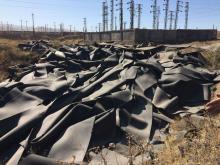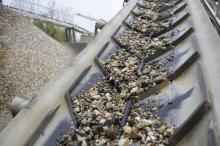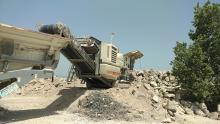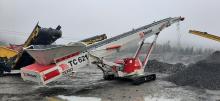
Selecting the right type of conveyor belt to handle abrasive and aggressive materials is key to achieving cost effective hauling, according to Dunlop conveyor belting's Les Williams
Conveyors can offer a highly effective method of on-site transportation but their durability and reliability can be critical factors in both productivity and cost management. The conveyor belt itself is often the most vulnerable component because it has to handle material that is hard, sharp and often abrasive too.
Technology used to manufacture conveyor belts has advanced enormously in recent years and modern users should expect a much higher level of performance and longer operational life from their belts.
"Unfortunately this is not always the experience as getting the best advice and guidance is not always as easy," explained
"As if to confuse things further, conveyor belt suppliers - and the companies that fit and maintain them - also seem to have developed a language all of their own, which can make specifying the right belt a difficult task." According to Williams, understanding the construction of a conveyor belt can help with selecting the right belt for the application in order to maximise service life.
"Rubber belts with 'multi-ply' textile reinforcement are the most commonly used type within the quarry and aggregate industry and usually consist of two elements," he explained. "Firstly, there is the carcass, which typically contains layers of extremely strong but flexible fabric embedded in the rubber. It is the carcass that provides the inherent characteristics of a conveyor belt such as its tensile strength and elongation, sometimes called elasticity or 'stretch' under tension.
"An outer cover of rubber protects the belt carcass and different types of rubber compound are used for rubber multi-ply belting covers. Each of the different compounds is designed to withstand damaging effects such as wear caused by abrasion, tearing and cutting, heat, fire and oil penetration. These different covers are generally referred to as 'cover grade qualities'. The most commonly used type of cover grade to carry aggregates is abrasion resistant." Williams added that selecting the best type of outer cover will largely determine the effectiveness and operational lifetime of conveyor belts.
"The wear resistance qualities of a conveyor belt are one of the major factors that determine its life expectancy and ultimately the truest test of its value for money," he said. "As a general rule, 80% of conveyor belt surface wear occurs on the top cover of the belt with approximately 20% of wear on the bottom cover.
"Wear on the top cover is primarily caused by the abrasive action of the materials being carried. This is increased at the loading point or 'station' where the belt is exposed to impact by the bulk material and at the discharge point where the material is effectively 'accelerated' by the belt surface.
"Contrary to popular belief, short belts - less than 50m - usually wear at a faster rate because they pass the loading and discharge points more frequently compared to longer belts. For these reasons, the selection of the correct type of cover quality and the thickness of shorter length belts becomes even more important than for other applications specifying the right conveyor can help prolong service life
"Wear on the bottom cover of the belt is mainly caused by the friction contact with the drum surface and idlers. The rate and uniformity of this type of wear can be adversely affected by many other factors such as misaligned or worn drums and idlers set at incorrect angles. Factors such as ozone penetration or an unclean environment where there is a build-up of waste material can accelerate wear. Belt cleaning systems, especially steel edged scrapers, can also cause wear to the top cover surface." Nonetheless, thicker belt covers do not necessarily improve wear life and specifying the right thickness can impact on operation. "The actual thickness of the cover is an important consideration," said Williams. "In principle, the difference in thickness between the top cover and the bottom cover should not exceed a ratio of more than 3 to 1.
"In theory, the more abrasive the material and the shorter the conveyor, the thicker the cover should be. In reality, the actual abrasion resistance quality of the belt cover is more important than the thickness. However, in an effort to compensate for poor abrasion resistant qualities, many conveyor belt suppliers offer belts with covers that are thicker than are actually necessary, which can potentially cause other operational problems." Williams said that it is a common misconception that a belt specifi ed by a supplier as being 'abrasion resistant' should not be expected to wear quickly.
"In actual fact, because of the variety of materials that are carried on conveyor belts, there are a number of different causes of wear and abrasion," he explained. "For example, heavy and/or sharp objects such as rocks can cause cutting and gouging of the belt surface whereas materials such as aggregate, sand and gravel literally act like sandpaper constantly scouring the rubber cover. For this reason, there are different types of abrasion resistant cover.
"There are two internationally recognised sets of standards for abrasion, EN ISO 14890 (H, D and L) and DIN 22102 (Y, W and X). In Europe, it is the longerestablished DIN standards that are most commonly recognised and accepted.
.
Generally speaking, DIN Y relates to 'normal' service conditions and DIN W for resistance to abrasion, cutting, impact (from high drop heights), and gouging resulting from large lump sizes of heavy and sharp materials.
"Each manufacturer uses its own mix or 'recipe' of polymers to create cover compounds that have different abrasion (wear) resistance qualities. The main polymers used are SBR (Styrene- Butadiene-Rubber) and BR (Butadiene- Rubber). Both SBR and BR have particularly good resistance not only to abrasion but also tearing, cutting, ripping and gouging. Many manufacturers try to avoid the use of natural rubber wherever possible in order to keep costs (prices) low.
"It is important that buyers of conveyor belts remember that DIN and ISO standards are only the minimum benchmark of acceptability. Wear resistant covers that conform to international standards still often have to be replaced after unacceptably short periods. Despite the claims of the manufacturers, tests reveal that more than 50% are found to be signifi cantly below those minimum standards.
"There is a lot more to specifying the right conveyor belt than just choosing the right length and they should not be selected just on price," said Williams. "The quality of a belt is usually refl ected by its price so it is always worth the effort to check the original manufacturers specifi cations carefully before opting for a different solution."









